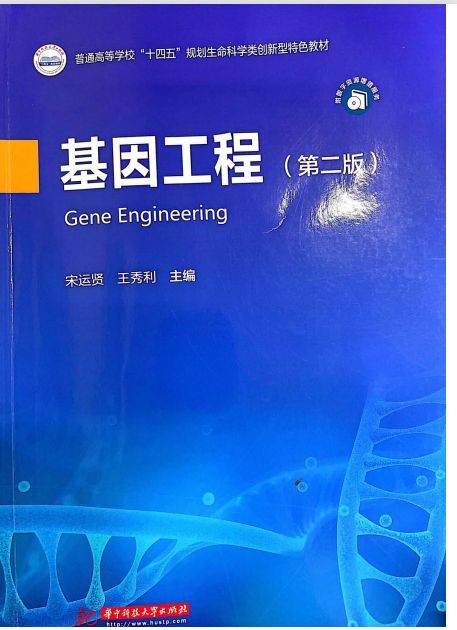基因工程是生物工程的核心技术,以微生物学、生物化学、分子生物学为基础,综合各种有关知识的应用技术学科。重点论述基因工程的基本原理及其单元操作,内容涉及 DNA 重组技术、分子克隆技术、外源基因的稳定高效表达技术等,以拓宽学生生命科学的知识面,为日后熟练驾驭这项技术服务于科学研究及国民经济打下坚实的基础。是实践性,应用性很强的专业课。
课程概述
《基因工程》是生物工程专业重要的专业课,代表着现代生物工程最新的发展前沿,在生命科学、农业、医药、食品、养殖业、生物资源与环境保护,新物种构建等领域发挥着越来越重要的作用。本课程重点讲授基因工程的基本原理及其单元操作,内容涉及常用的技术方法、工具酶、载体、目的基因的制备、外源基因的导入,重组子的检测,外源基因的高效表达等内容。通过对本课程的学习,希望您能掌握基因工程的基础知识、基本理论、基本原理;使您对基因工程有一个全方位的、比较系统的认识,为运用基因工程手段解决实际问题形成一种必要能力,为进一步的深造打下重要的理论基础。本课程在讲授过程中采用英文课件,结合中英文字幕,为双语教学打下了基础。另外本课程突出实用性、科学性,注重思政元素的无声渗透。
课程大纲
- Chapter-1 Introduction and Course Overview
- Part-1 The concept and birth of GE
- Part-2 The application of GE
- Part-3 Safety and Ethical Discussions
- Part-4 第一章习题及答案
- Part-5 作业
- Part-6 讨论
- Chapter-2 Enzymes used in genetic engineering
- Part-1 2.1.1 Restriction endonuclease
- Part-2 2.1.2 Typical Restriction Digest
- Part-3 2.1.3Restriction Maps
- Part-4 2.2DNA ligase and joining DNA molecules
- Part-5 2.3 DNA Polymerase and modifying enzymes
- Part-6 2.4 Nucleases
- Part-7 2.1.1 Restriction endonuclease
- Part-8 2.1.2 Typical Restriction Digest
- Part-9 2.1.3 Restriction Maps
- Part-10 2.2 DNA ligase and joining DNA molecules
- Part-11 2.3 DNA Polymerase and modifying enzymes
- Part-12 2.4 Nucleases
- Part-13 第二章 习题及答案
- Chapter-3 Vectors
- Part-1 3.1 The characters and types of vectors
- Part-2 3.2.1 Plasmid biology and isolation
- Part-3 3.2.2 Popular plasmid vector
- Part-4 3.3Phage λ cloning vectors
- Part-5 3.4 Single-stranded phages vector
- Part-6 3.5 Vectors for cloning large fragments of DNA
- Part-7 3.1 The characters and types of vectors
- Part-8 3.2.1 Plasmid biology and isolation
- Part-9 3.2.2 Popular plasmid vector
- Part-10 3.3Phage λ cloning vectors
- Part-11 3.4 Single-stranded phages vector
- Part-12 3.5 Vectors for cloning large fragments of DNA
- Part-13 第三章习题及答案
- Chapter-4 Chapter4 Basic techniques
- Part-1 4.1.1Total cell DNA extraction
- Part-2 4.1.2 Measurement of DNA concentration and DNA Purification
- Part-3 4.1.3 the preparation of RNA
- Part-4 4.2.1 Agarose gels
- Part-5 4.2.2 Polyacrylamide Gel Electrophoresis
- Part-6 4.3 PCR
- Part-7 4.4 Site-directed mutagenesis
- Part-8 4.5.1 Ways of Molecular Hybridization
- Part-9 4.5.2 Probe labeling
- Part-10 4.1.1Total cell DNA extraction
- Part-11 4.1.2 Measurement of DNA concentration and DNA Purification
- Part-12 4.1.3 the preparation of RNA
- Part-13 4.2.1 Agarose gels
- Part-14 4.2.2 Polyacrylamide Gel Electrophoresis
- Part-15 4.3 PCR
- Part-16 4.4 Site-directed mutagenesis
- Part-17 4.5.1 Ways of Molecular Hybridization
- Part-18 4.5.2 Probe labeling
- Part-19 第四章习题及答案
- Chapter-5 chapter 5 Gene of interest isolation and Cloning
- Part-1 第五章习题及答案
- Part-2 5.1.1 Isolation of Gene of Interest
- Part-3 5.1.2 Constructing a genomic and cDNA library
- Part-4 5.2.1 Sequence-dependent screening
- Part-5 5.2.2 Difference cloning
- Part-6 5.2.3 Screening expressing libraries
- Chapter-6 Chapter6:Introduction of DNA into living cells
- Part-1 6.1 Introduction of DNA into bacterial cells
- Part-2 6.2 Identification of recombinants
- Part-3 6.1Introduction of DNA into bacterial cells
- Part-4 6.2 Identification of recombinants
- Part-5 第六章习题及答案
- Chapter-7 chapter 7 Plant Genetic Engineering
- Part-1 第七章习题及答案
- Part-2 7.1 Overview of transgenetic plant
- Part-3 7.2.1Characteristics of Agrobacteria and Classes of Transformation Vectors
- Part-4 7.2.2Agrobacterium Protocols---Transformation
- Part-5 7.2.3Direct gene transfer methods
- Part-6 7.3Analyzing the Transgenic Plants
- Part-7 7.4Strategy in Improvement of Plant Properties
- Chapter-8 chapter8 Genetic Engineering of Animals
- Part-1 8.1 Transgenic animals
- Part-2 8.2 gene therapy
- Part-3 第八章习题及答案
- Chapter-9 chapter9 Achieving high-level expression of genes in host cell
- Part-1 9.1.1 Prokaryotic Expression Systems
- Part-2 9.1.2 Eukaryotic expression system
- Part-3 9.2Strategies for Analyzing Gene Expression
- Part-4 9.3 Methods for Identifying biological functions of genes
- Part-5 第九章习题及答案
- Chapter-10 1-4章测试1
- Chapter-11 1-4章生工测试2
- Chapter-12 1-4章生物工程测试3
授课目标
1.使学生了解掌握与基因工程相关的重要理论,背景知识和基因工程学的基础知识。
2.使学生理解基因工程的各种技术的基本原理,技术路线和方法。
3.使学生了解掌握掌握基因工程的四大要素。
4.使学生了解掌握转基因动植物培育的流程。
5.在掌握基本知识的前提下,能针对具体课题对重要技术的技术路线进行初步设计。
预备知识
本课程以微生物学、生物化学、分子生物学为基础,综合各种有关知识的应用技术学科,因此需先修微生物学、生物化学、分子生物学、遗传学等课程。
|
5.0
|
共
3
条评价
|
本次开课
查看全部
|
|
5.0
|
共
4
条评价
|
本次开课
查看全部
|
1
这门课程是免费学习的吗?
本课程是开设在安徽省网络课程学习中心(e会学)平台上的课程,是免费学习的。
2
是否需要完成课程所有的作业?
如果你想要获得课程证书,你需要按照课程老师制定的课程大纲和考核标准完成相关作业;如果仅是为了扩充知识并不需要申请证书,可以根据自己的时间与需求自由安排学习计划。
3
课程结束后,还能继续学习课程内容吗?
这将根据课程团队的设置的课程结课设置而定,有的课程将在课程结束后关闭,有的课程允许已选课的用户查看课程内容及历史记录,也有课程可能会对未选课用户开放课程内容。对于结课后仍然开放的课程,在“我的课程”列表里,可以查看课程内容及学习记录。





